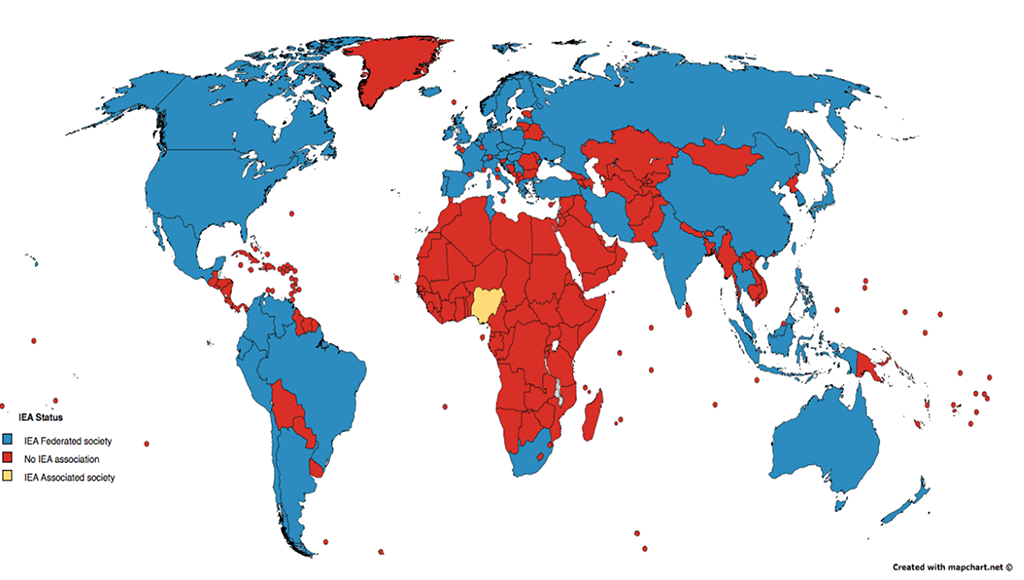Date:Jun 2016
Identifying global Human Factors and Ergonomics development needs
The IEA recently held an executive Committee meeting in San Francisco during which the various standing Committee chairs presented their three-year action plans, including the International Development (ID) Committee. The following is a brief summary of some of the ideas that were presented at the meeting by the chair of the ID Committee. A starting point to the development of a strategy for increasing the number of federated societies within the IEA is to first understand the current global and regional representation of the IEA. Figure 1 is a map of the world demonstrating the countries that currently (in blue) have a Human Factors and Ergonomics association or society that is federated or affiliated to the IEA. This figure eloquently demonstrates the key strategic areas the IEA International Development Committee needs to focus on for future development.

Figure 1: Global representation as federated and affiliated societies of the International Ergonomics Association.
The IEA currently has 54 federated or affiliated societies originating from all over the world. However, European societies form the largest proportion of the IEA membership (28 societies or associations are from Europe), while Asia (24%) and the Americas (17%) are further prominent contributors to IEA membership. Contrastingly Africa and the Oceania regions constitute only about 8% of the societies represented in the IEA. If the various regions of the world are further broken down using the United Nations Geoscheme (http://unstats.un.org/unsd/methods/m49/m49regin.htm#americas) for global demarcations it provides further interesting data on each particular region of the world. It is particularly interesting to note that no single region in the world has more than a 53% representation in the IEA, indicating that there remains an exciting scope for further development all over the world:
- Africa: With only the northern and southern most tips of Africa represented in the IEA as federated societies (and Nigeria as an affiliated society in Western Africa) it is clear that all regions of the African continent remain as important development objectives for the IEA.
- Asia: IEA representation is relatively strong in South-East and Eastern Asia, including the SEANES Network. Southern, Central and Western Asia however have less development in terms of ergonomics and these latter regions are thus an important focus point for the ID Committee.
- The Americas: There has been impressive growth in Latin America with many of these countries now belonging to the IEA. ULAERGO (Union of Latin American Ergonomics Societies) needs to be congratulated for the work they have done in this region, and the ID Committee will continue to support their initiatives. Contrastingly, Central America has only Mexico as a federated society and as such is an important area for development.
- Europe has the strongest representation in the IEA with most regions demonstrating pleasing membership rates and a strong network in FEES. However, Southern Europe is a concern with less than 50% of the countries in this region belonging to the IEA. The IEA president and ID Committee chair will be visiting this area shortly as part of the development strategy.
- In the Oceania region New Zealand and Australia are the two countries with federated societies while the smaller island states in the region have no formal relationship with the IEA.
It is clear that there is tremendous potential for continued growth in IEA membership. The International Development Committee is in the process of establishing closer working relationships with both the societies in the various regions, and where they exist, the IEA Networks in these regions. It is the belief of the Committee that it is imperative that any development initiatives by the IEA are done in a participatory manner and are focused on developing sustainable and meaningfully contributing member societies. To achieve this the International Development Committee has both long term and short term strategies. From a long term perspective, the Committee aims to develop a flexible conceptual framework for international development and allows for application in diverse contexts and speaks to funding, training and problem-solving models. While from a shorter term perspective the Committee aims at helping with the continuing education and upskilling of local communities with a focus on the development of local stakeholder collaboration.
Lastly it is my great pleasure to welcome Professor Gaur Ray from the Indian Society of Ergonomics, Professor Rosemary Seva from the Human Factors and Ergonomics Society of the Philippines and Professor Paulo Oliveira from the Brazilian Ergonomics Association as Co-Chairs of the ID standing Committee. We are looking forward to working together to further the objectives of the IEA through its international development initiatives.
Andrew Todd,
International Development Committee Chair